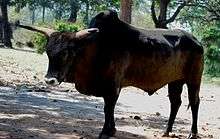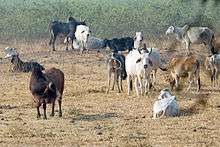Indian aurochs
| Bos primigenius namadicus Temporal range: Pleistocene–Holocene | |
|---|---|
 | |
| Speculative life restoration of the enigmatic Indian aurochs (B. p. namadicus) | |
| Scientific classification | |
| Kingdom: | Animalia |
| Phylum: | Chordata |
| Clade: | Synapsida |
| Class: | Mammalia |
| Order: | Artiodactyla |
| Family: | Bovidae |
| Subfamily: | Bovinae |
| Genus: | Bos |
| Species: | B. primigenius |
| Subspecies: | B. p. namadicus |
| Trinomial name | |
| Bos primigenius namadicus (Falconer, 1859) | |
The Indian aurochs (Bos primigenius namadicus) is a subspecies of the extinct aurochs. It is considered as the ancestor of the zebu cattle, which is mainly found in southern Asia and has been introduced in many other parts of the world, like Africa and South America. In contrast, the taurine cattle breeds, which are native to Europe, the Near East, and other parts of the world, are descendants of the Eurasian aurochs (Bos primigenuis primigenius). The Indian aurochs disappeared in the Holocene, probably around 2000 BC.
Description
The Indian aurochs is known from fossil and subfossil remains. These show relatively slight differences to the Eurasian aurochs (B. p. primigenius).[1] The Indian aurochs was probably smaller than its Eurasian counterpart but had proportionally larger horns.[2] Because the range of the aurochs probably was continuous from Portugal to India, it is uncertain whether there was a clear distinction or a continuum between the Eurasian and Indian subspecies.[2]
The Indian aurochs diverged from the Eurasian aurochs (B. p. primigenius) about 100,000 - 200,000 years ago. This has been shown by comparison of DNA from zebus and taurine cattle breeds, the living descendants of these two aurochs forms.[3] The Indian aurochs is sometimes regarded as a distinct species.[4] Zebu cattle is phenotypically distinguished from taurine cattle by the presence of a prominent shoulder hump.[5]
Range
The aurochs originated about 2 million years ago in India and spread westwards.[2] The Indian aurochs roamed in the Pleistocene and Holocene epochs throughout the Indian subcontinent from Baluchistan, the Indus valley and the Ganges valley to south India. Most remains are from the north of India, on the Kathiawar Peninsula, along the Ganges, and from the area of the Narmada River. However, bone remains of the Indian aurochs are present in the south as well, such as the Deccan area and along the Krishna area.[2] The wild Indian aurochs survived into neolithic times, when it was domesticated. The youngest known remains, which clearly belong to wild Indian aurochs are from Banahalli in Karnataka, southern India, with an age of about 4200 years old.[6]
Possible predators preying on the wild type of the zebu were big cats such as lions, leopards and tigers, as well as other predatory mammals such as dholes and even spotted hyenas during prehistoric times.
Domestication

The first centre for domestication of the Indian aurochs was probably the Baluchistan region in Pakistan. The domestication process seems to have been prompted by the arrival of new crop species from the Near East around 7000 BC. It is possible, that Indian aurochs were domesticated independently in Southern India, in Gujarat and the Ganges floodplains. Domestic zebu are recorded from the Indus region since 6000 BC and from south India, the middle Ganges region, and Gujarat since 2000-3500 BC. Domestic cattle seem to have been absent in southern China and southeast Asia until 2000-1000 BC.[6]
Dedomestication: feral zebu cattle
A feral population of zebu cattle is found in the Kuno Wildlife Sanctuary in Madhya Pradesh.[7] The zebu were left there as a potential prey for Asiatic lions and will thus fill the ecological role of their wild ancestors.[8][9]
External links
- online link to Bos namadicus skull in: Raphael Pumpelly: Explorations in Turkestan : Expedition of 1904 : vol.2, p. 361
References
- ↑ Raphael Pumpelly: Explorations in Turkestan : Expedition of 1904 : vol.2, p. 361
- 1 2 3 4 Cis van Vuure: Retracing the Aurochs - History, Morphology and Ecology of an extinct wild Ox. 2005, ISBN 954-642-235-5.
- ↑ Verkaar, Nijman, Beeke, Hanekamp & Lenstra: Maternal and Paternal Lineages in Cross-breeding bovine species. Has Wisent a Hybrid Origin?. 2004.
- ↑ MacHugh et al., 1997: Microsatellite DNA Variation and the Evolution, Domestication and Phylogeography of Taurine and Zebu Cattle (Bos taurus and Bos indicus). Genetics, Vol. 146, 1071–1086. Abstract
- ↑ Loftus et al., 1994: Evidence for two independent domestications of cattle. Proceedings of the National Academy of Sciences 91.7: 2757-2761. Abstract
- 1 2 Chen et al., 2010: Zebu cattle are an exclusive legacy of the South Asia Neolithic. Molecular biology and evolution, 27(1), 1-6. Abstract
- ↑ Ganesh Ghosh: Evaluating prospects of reintroducing Cheetahs (Acinonyx jubatus) in Kuno Wildlife Sanctuary. TIGERPAPER Vol. 36: No. 2 April–June 2009
- ↑ A.J.T. Johnsingh (2004) "Is Kuno Wildlife Sanctuary ready to play second home to Asiatic lions?", published in the Newsletter of Wildlife Institute of India (WII). Archived version at https://groups.yahoo.com/neo/groups/Asiatic_Lions/conversations/topics/155.
- ↑ Preparations for the reintroduction of Asiatic lion Panthera leo persica into Kuno Wildlife Sanctuary, Madhya Pradesh, India by A.J.T. Johnsingh, S.P. Goyal, Qamar Qureshi; Cambridge Journals Online; Oryx (2007), 41: 93-96 Cambridge University Press; Copyright 2007 Fauna & Flora International; doi:10.1017/S0030605307001512; Published online by Cambridge University Press 05Mar2007